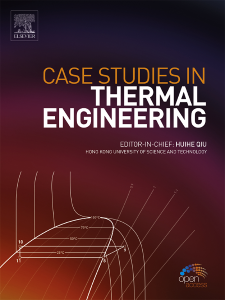带有倾斜磁场和热辐射的旋转系统中的 MHD 混合纳米流体流动
IF 6.4
2区 工程技术
Q1 THERMODYNAMICS
引用次数: 0
摘要
纳米流体的创新在减少摩擦和提高热传递率方面做出了重大贡献。因此,本研究的目的是研究旋转系统中纳米流体的磁流体力学流动,以实现热量、质量和微生物的传递。旋转系统的下板和上板分别位于 y0 和 yh 处。不同的固体纳米粒子(如铜、石墨烯)和氧化物纳米粒子(如氧化钛、氧化铝)以及作为基液的水被用来制备不同的混合纳米流体。这种流体可应用于医疗技术、航空航天、冷却系统、热疗以及核反应堆和太阳能系统等能源系统。此外,它还能在水处理过程中改善污染物的移动和清除,从而改善环境工程。这些不同的应用凸显了当前研究的重要性。详细讨论了热量、质量和微生物的传输,其中包括磁力和热辐射效应。通过相似函数,将控制方程转换为相互关联的常微分方程(ODE)。利用 MATLAB 的 bvp4c ODE 求解器,得出了数值和图形解决方案。详细探讨了热泳、佩克莱特数、施密特数、倾角、磁场和旋转等各种参数对速度、温度、体积浓度和运动浓度的影响。值得注意的是,当辐射参数在 0 到 15 之间变化时,热传导率最大,突出表明在无辐射的情况下热传导率最大。佩克莱特数在 5 到 20 之间时,Cu/石墨烯纳米颗粒流体的微生物运动传输率在 7.3 到 20 之间变化,Al2O3/TiO2 纳米颗粒流体的微生物运动传输率在 6.4 到 21 之间变化。这表明了两种混合纳米流体的效率。本文章由计算机程序翻译,如有差异,请以英文原文为准。
MHD hybrid nanofluid flow in a rotating system with an inclined magnetic field and thermal radiation
The innovation of nanofluid has contributed significantly towards a decrease in friction and an increase in heat transmission rates. So, the purpose of this research is to investigate magnetohydrodynamics nanofluid flow in a rotating system for heat, mass, and microorganism transfer. The rotating system has lower and upper plates positioned at and . Different solid nanoparticles i.e. copper, graphene, and oxide nanoparticles i.e. titanium oxide, aluminum oxide, and water as base fluid are used to prepare different hybrid nanofluids. Such fluids have applications in medical technologies, aerospace, cooling systems, hyperthermia treatment, and energy systems like nuclear reactors and solar systems. Additionally, it improves environmental engineering by improving pollutant movement and removal during water treatment. These different applications highlight the importance of present research. Heat, mass, and microorganism transmission incorporating inclined magnetic force and thermal radiation effects are discussed in detail. Through a similarity function, the governing equations are transformed into interconnected ordinary differential equations (ODEs). Using MATLAB's bvp4c ODE solver, numerical and graphical solutions are derived. Detailed exploration is conducted on the impacts of various parameters such as thermophoresis, Peclet number, Schmidt number, inclination angle, magnetic field, and rotation on velocity, temperature, volumetric concentration, and motile concentration. Notably, the maximum heat transfer rate occurs when the radiation parameter varies from 0 to 15, highlighting maximum heat transfer in the absence of radiation. The Peclet number is between 5 and 20, and the motile microorganism transmission rate changes from 7.3 to 20 for Cu/Graphene nanoparticles and 6.4 to 21 for nanoparticles fluid. This shows the efficiency of both types of hybrid nanofluids.
求助全文
通过发布文献求助,成功后即可免费获取论文全文。
去求助
来源期刊

Case Studies in Thermal Engineering
Chemical Engineering-Fluid Flow and Transfer Processes
CiteScore
8.60
自引率
11.80%
发文量
812
审稿时长
76 days
期刊介绍:
Case Studies in Thermal Engineering provides a forum for the rapid publication of short, structured Case Studies in Thermal Engineering and related Short Communications. It provides an essential compendium of case studies for researchers and practitioners in the field of thermal engineering and others who are interested in aspects of thermal engineering cases that could affect other engineering processes. The journal not only publishes new and novel case studies, but also provides a forum for the publication of high quality descriptions of classic thermal engineering problems. The scope of the journal includes case studies of thermal engineering problems in components, devices and systems using existing experimental and numerical techniques in the areas of mechanical, aerospace, chemical, medical, thermal management for electronics, heat exchangers, regeneration, solar thermal energy, thermal storage, building energy conservation, and power generation. Case studies of thermal problems in other areas will also be considered.
 求助内容:
求助内容: 应助结果提醒方式:
应助结果提醒方式:


